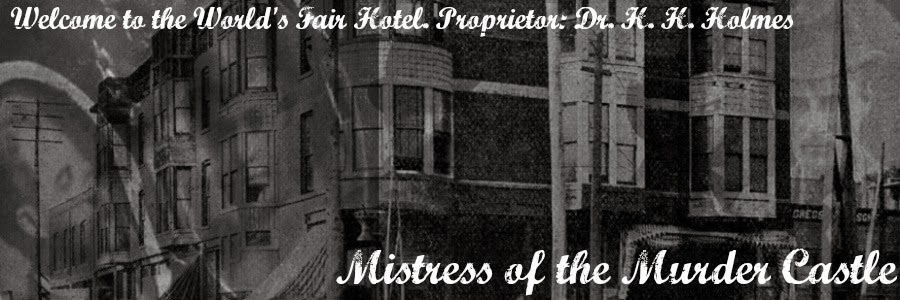Holmes tried to remove the nails from his rapidly sealing coffin by persuading the Pennsylvania Supreme Court to give him a new trial but they denied the appeal. It was on March 6, 1896, in the article pictured below, that the Philadelphia Inquirer reported, "Governor Hastings today named Thursday, May 7th, as the date for the execution…The Governor thought Holmes should have at least sixty days in which to prepare for death" and repent for the murder of Pitezel.
Holmes used his remaining time in prison to write either two or three different confessions. The most famous and well known was from April of 1896 when Holmes "confessed" to slaughtering 27 people. I write "confessed" with quotation marks because the document was riddled with lies and exaggerations. Some of the victims were still alive. Another had been killed in a train crash. But Holmes was dying regardless of what he did or said and knew people would remember a heartless monster far longer than a man who merely protested his innocence until the end. He was right as his story lives on almost 120 years after his death.
Aside from his various confessions, Holmes also wrote plenty of letters while behind bars. The recipients included Detective Frank Geyer, who found the bodies of the three missing Pitezel children, Carrie Pitezel, the widow of Benjamin, and Samuel Pennypacker.
The Pennypacker letter still exists. Housed in the Library of Congress Rare Book room, it is tucked away inside the cover of a rare first edition copy of Holmes' Own Story.
A native of Pennsylvania, Pennypacker served as governor from 1903 to 1907. In 1889, he was appointed judge of the Court of Common Pleas No. 2. Pennypacker would eventually be promoted to President Judge but not until after Holmes wrote to him in January of 1896. "The Annual Report of the State Treasurer of the Commonwealth of Pennsylvania" for September 1896 (Holmes was executed May 7th) lists Pennypacker as "additional law judge."
Aside from his various confessions, Holmes also wrote plenty of letters while behind bars. The recipients included Detective Frank Geyer, who found the bodies of the three missing Pitezel children, Carrie Pitezel, the widow of Benjamin, and Samuel Pennypacker.
(Samuel Pennypacker)
The Pennypacker letter still exists. Housed in the Library of Congress Rare Book room, it is tucked away inside the cover of a rare first edition copy of Holmes' Own Story.
A native of Pennsylvania, Pennypacker served as governor from 1903 to 1907. In 1889, he was appointed judge of the Court of Common Pleas No. 2. Pennypacker would eventually be promoted to President Judge but not until after Holmes wrote to him in January of 1896. "The Annual Report of the State Treasurer of the Commonwealth of Pennsylvania" for September 1896 (Holmes was executed May 7th) lists Pennypacker as "additional law judge."
In his letter, Holmes stated that he was writing at the request of his attorney, Samuel Rotan. When not representing himself in court, Holmes was represented by Rotan and William Shoemaker.
The letter to Pennypacker reads:
Philadelphia County Prison Jan. 30 1896
To the Honorable Samuel W. Pennypacker
Court of Common Pleas
Dear Sir -
At the request of my attorney S. P. Rotan Esq. Ginard Bld. Phil. I take pleasure in addressing to your Honor these lines to which I append my, at present, very unenviable signature.
(Samuel Rotan)
(William Shoemaker)
The letter to Pennypacker reads:
Philadelphia County Prison Jan. 30 1896
To the Honorable Samuel W. Pennypacker
Court of Common Pleas
Dear Sir -
At the request of my attorney S. P. Rotan Esq. Ginard Bld. Phil. I take pleasure in addressing to your Honor these lines to which I append my, at present, very unenviable signature.
I am Sir, Very Respectfully Yours,
HW Mudgett M.D.
alias
HH Holmes
For once, Holmes was not explicitly writing to ask someone for a favor. It seems that Pennypacker may have contacted Rotan about getting Holmes' autograph, Rotan passed the message along to Holmes, and Holmes responded.
This wasn’t the last time Rotan was approached by relic seekers. Once the public learned Holmes would be executed, scientists, doctors, and lovers of the macabre offered to pay Rotan insane amounts of money for everything from Holmes' brain to his entire body. All requests were promptly denied. Though encased in concrete, the body of H. H. Holmes still remains fully intact ten feet under the grass of Pennsylvania's Holy Cross Cemetery. However, a piece of Holmes still remains behind in Washington, D.C.
Civil War General Joshua Lawrence Chamberlain once said, "Forms change and pass; bodies disappear; but spirits linger." It is impossible to touch that thin, worn paper, filled with ink and small bumps where the pen was applied with more than enough pressure and not sense the author coming alive again. And if you close your eyes, you can still feel the hand, the wrist, and the pulse of the man who changed America.
Until next time.
XOXO, Kate
The pictures of the Pennypacker letter are mine so please do not reprint them without permission.








